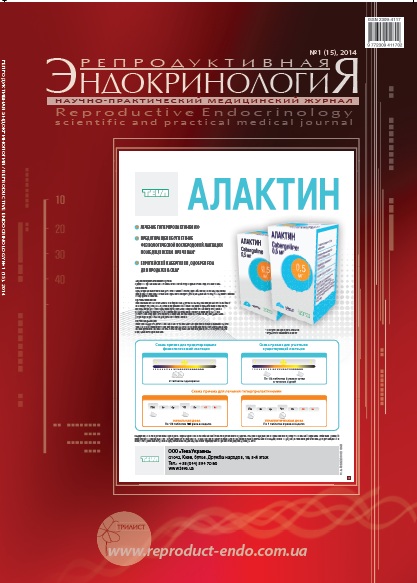New approaches to prevention and management of preterm labor
DOI:
https://doi.org/10.18370/2309-4117.2014.15.70-76Keywords:
pregnancy, premature birth, micronized progesteroneAbstract
In the framework of the II National Congress «Controversial issues of modern obstetrics» and the XI World Congress of Perinatal Medicine, which was held in St. Petersburg on 16-18 June 2013, considerable attention was paid to the problem of premature birth, especially very early (22-27 weeks) which are a major cause of neonatal morbidity and mortality. It was discussed pathogenetic causes and risk factors, as well as the possibility of drug prevention of preterm birth. It was noted that prophylactic use micronized progesterone vaginally in pregnant women with threatened preterm labor allows to prolong pregnancy and reduce the likelihood of complications in labor and postpartum period in mother and child.
References
- Tyson JE, Prarikh NA, Langer J et al. Intensive care for extreme prematurity: moving beyond gestational age // N. Engl. J. Med. – 2008. – Vol. 358, № 16. – P. 1672–1681.
- Saigal S, Hoult LA, Streiner DL et al. School difficulties at adolescence in a regional cohort of children who were extremely low birth weight // Pediatrics. – 2000. – Vol. 105, № 2. – P. 325–331.
- Arzhanova ON, Kosheleva NG Etiopathogenesis of miscarriage // Russian Gazette of Obstetrician-Gynecologist. – 2004. – T. 13, No. 1. – P. 37–41.
- Pustotina OA Progesterone drugs in complex treatment of preterm labor // Effective pharmacotherapy in obstetrics and gynecology. – 2006. No 1. – P. 16–17.
- Dobrokhotova JE Criteria for selection of progestogens in the treatment of miscarriage // Academy Bezen. – 2010. No. 4. – P. 3–32.
- da Fonseca EB, Bittar RE, Carvaiho MH et al. Prophylactic administration of progesterone by vaginal suppository to reduce the incidence of spontaneous preterm birth in women at increased risk: a randomized placebo-controlled double-blind study // Am. J. Obstet. Gynecol. – 2003. Vol. 188, № 2. – P. 419–424.
- Meis PJ, Klebanoff M, Thom E et al. Prevention of recurrent preterm delivery by 17 alpha-hydroxyprogesterone caproate // N. Engl. J. Med. – 2003. – Vol. 348, № 24. – P. 2379–2985.
- da Fonseca EB, Celik E, Parra M et al. Progesterone and the risk of preterm birth among women with a short cervix // N. Engl. J. Med. – 2007. – Vol. 357, № 5. – P. 462–469.
- Romero R, Nicolaides K, Conde-Agudelo A et al. Vaginal progesterone in women with an asymptomatic sonographic short cervix in the midtrimester decreases preterm delivery and neonatal morbidity: a systematic review and metaanalysis of individual patient data // Am. J. Obstet. Gynecol. – 2012. Vol. 206, № 2. P. – 124.e1–19. 60.
- Kurkinen-Raty M, Kivela A, Jouppila P The clinical significance of an absent end-diastolic velocity in the umbilical artery detected before the 34th week of pregnancy // Acta Obstet. Gynecol. Scand. – 1997. Vol. 76, № 5. – P. 398–404.
- Berghella V, Hayes E, Visintine J Fetal fibronectin testing for reducing the risk of preterm birth // Cochrane Database Syst. Rev. – 2008. – Vol. 8, № 4. CD006843.
- Su LL, Samuel M, Chong YS Progestational agents for treating threatened or established preterm labour // Cochrane Database Syst. Rev. – 2010. – Vol. 20, № 1. CD006770.
- De Franco EA, O’Brien JM, Adair CD et al. Vaginal progesterone is associated with a decrease in risk for early preterm birth and improved neonatal outcome in women with a short cervix: a secondary analysis from a randomized, double-blind, placebo-controlled trial // Ultrasound Obstet. Gynecol. – 2007. Vol. 30, № 5. – P. 697–705.
- Progesterone and preterm birth prevention: translating clinical trials data into clinical practice / Society for Maternal-Fetal Medicine Publications Committee, with assistance of V. Berghella // Am. J. Obstet. Gynecol. – 2012. – Vol. 206, № 5. – P. 376–386.
- Di Renzo GC, Roura LC, Facchinetti F et al. Guidelines for the management of spontaneous preterm labor: identification of spontaneous preterm labor, diagnosis of preterm premature rupture of membranes, and preventive tools for preterm birth // J. Matern. Fetal. Neonatal. Med. – 2011. Vol. 24, № 5. – P. 659–667.
Downloads
Published
How to Cite
Issue
Section
License
Copyright (c) 2014 О. Ф. Серова, Д. Фарин, Н. И. Тапильская

This work is licensed under a Creative Commons Attribution 4.0 International License.
Authors who publish with this journal agree to the following terms:
- Authors retain copyright and grant the journal right of first publication with the work simultaneously licensed under a Creative Commons Attribution License that allows others to share the work with an acknowledgement of the work's authorship and initial publication in this journal.
- Authors are able to enter into separate, additional contractual arrangements for the non-exclusive distribution of the journal's published version of the work (e.g., post it to an institutional repository or publish it in a book), with an acknowledgement of its initial publication in this journal.







